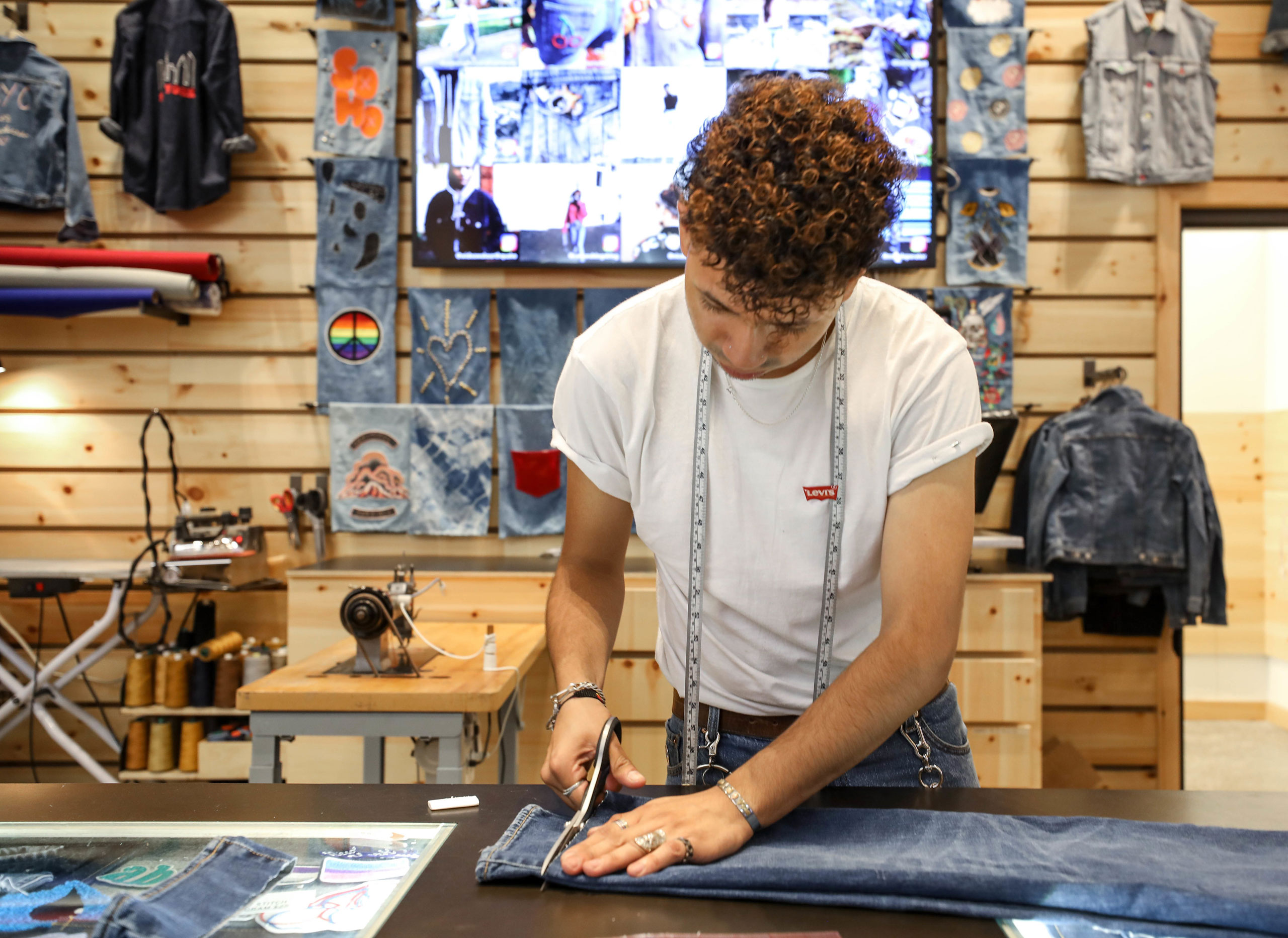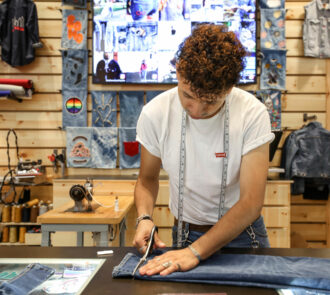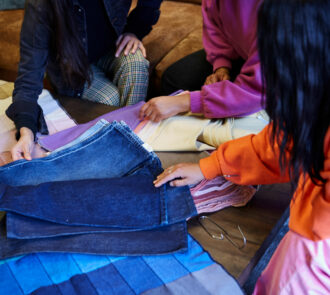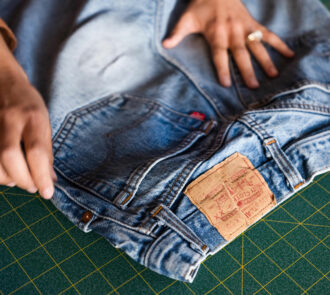Relevant frameworks in this pillar: GRI, SASB, UN SDGs
Contributing to these UN SDGs: 6, 12, 13, 15
We have long been committed to contributing to a more just society and a better world. This means using our scale, reach and platform to advocate for positive change, address overconsumption and drive toward a more sustainable, less resource-intensive apparel industry. It also means looking past the traditional take-make-waste model toward a circular economy, where nothing is wasted in the manufacture, use and reuse of products. And it means engaging consumers, peers and industry groups in this shared journey to a sustainable future.
In 2021, LS&Co. continued to encourage innovation and broader action on the path to embracing a circular economy and reducing resource consumption. This included bringing to market our first-ever circular Levi’s® 501® jean, which contains a blend of organic cotton and fiber spun from discarded denim. We also launched “Buy Better, Wear Longer” — a global marketing campaign that encourages consumers to be more intentional about purchasing decisions and emphasizes our own commitment to becoming more sustainable across our operations.
Throughout our industry, brands must establish a different relationship with the idea of consumption as it applies to consumers and to ourselves — it takes all of us to solve this challenge. That’s why consumption is a key part of our broader approach to sustainability, because if we’re not talking about consumption and helping to change the paradigm, we will not see the progress our business, our communities and our planet require.
Consumption Goals
Key markets to introduce or increase resale and upcycling initiatives to extend the life of our products
By 2025
Key markets to introduce or increase resale and upcycling initiatives to extend the life of our products
By 2025
Circular ready*
In 2026*
Circular ready*
In 2026*
Zero-waste-to-landfill from company-operated facilities and 50% waste diversion across strategic suppliers**
By 2030
Zero-waste-to-landfill from company-operated facilities and 50% waste diversion across strategic suppliers**
By 2030
Eliminate single-use plastics in consumer-facing packaging by shifting to 100% reusable, recyclable or home compostable plastics
By 2030
Eliminate single-use plastics in consumer-facing packaging by shifting to 100% reusable, recyclable or home compostable plastics
By 2030
Strategic garment wet finishing manufacturing and fabric mills use 100% certified screened chemistry***
By 2026
Strategic garment wet finishing manufacturing and fabric mills use 100% certified screened chemistry***
By 2026
Use only third-party preferred or certified more sustainable primary materials****
By 2030
Use only third-party preferred or certified more sustainable primary materials****
By 2030
*Product will be considered circular ready when it meets all pillars of the Ellen MacArthur Foundation Make Fashion Circular Framework. Note that LS&Co. product will not be fully circular in 2026, but that the company is prepared to set forth a path by 2026 to bring fully circular products to market. Of note, the time horizon for this goal has shifted to 2026 due to the impact of supply chain challenges and other external factors.
**In alignment with the Zero Waste International Alliance and TRUE Zero Waste certification, facilities that reach the 90% threshold will be designated as zero waste. We are committed to sharing our waste diversion progress.
***Strategic garment wet finishing manufacturing and fabric mills cover approximately 80% of product weight.
****In this context, “preferred” is based on the Textile Exchange, which defines a preferred fiber or material “as one which results in improved environmental and/or social sustainability outcomes and impacts in comparison to conventional production.”
Consumption Highlights
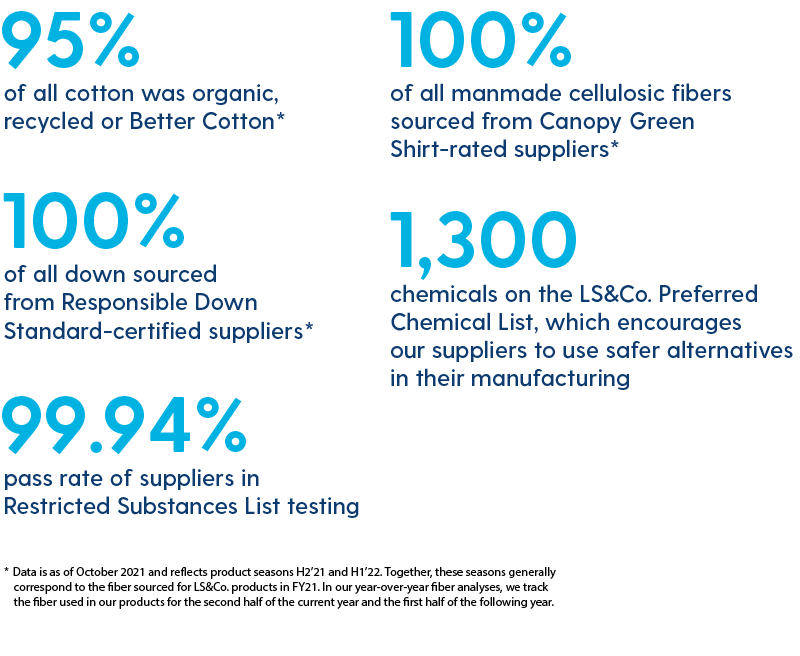
Forward-Looking Statements
This Sustainability Report and related website contain forward-looking statements, including statements related to our sustainability strategies, initiatives and targets. We based these forward-looking statements on our current assumptions, expectations and projections. These forward-looking statements are estimates and involve a number of risks and uncertainties that could cause actual results to differ materially. These risks and uncertainties are detailed in our filings with the U.S. Securities and Exchange Commission, including our Forms 10-K and 10-Q. Other unknown or unpredictable factors also could have material effects on our future results, performance or achievements. All information in this Sustainability Report and related website was current only as of the date originally presented and we disclaim any obligation to update this information.
More About Consumption



